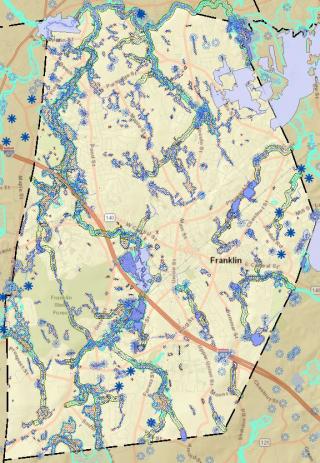Homeowners 101

As a homeowner, you have a lot to manage. This page is designed to help alleviate confusion and stress surrounding jurisdictional Wetland Resource Areas. Please see below for more information about resources, permitting, and how to navigate through everything "Conservation"
Questions? Contact the Conservation Agent and Natural Resource Protection Manager, Breeka Li Goodlander via email at bgoodlander@franklinma.gov or by phone at (508) 520-4847.
Discovering Wetland Resource Areas - A Helpful Guide
The Town of Franklin recognizes Wetlands, Rivers, Bordering/Isolated Land Subject to Flooding (i.e. floodplain/zone), Vernal Pools, Estimated/Priority Habitats, Perennial and Intermittent Streams, and their respective Buffer Zones as jurisdictional Wetland Resource Areas (WRAs). These Areas may not always be obvious. Thankfully, there are simple steps you can take to learn if your property has any WRAs within its boundaries! Click the link below to see more.
What do I do if there are beavers on my property?
Beavers are industrious aquatic mammals and a necessary keystone species. They are unique in that they modify their habitat by building dams to meet their needs for food and shelter. Throughout the course of these modifications, beavers may cause significant adverse impacts to both public and private property. To address these potential impacts, there are three separate government departments involved in mitigating beaver issues.
- Franklin Conservation Department/Commission - for work within any jurisdictional WRAs (e.g. beaver dam removal);
- Franklin Health Department/Board of Health - for "threats to human health and safety";
- and the Massachusetts Division of Fish and Wildlife (DFW) - for trapping, dam breaching, etc.
The Conservation Department/Commission has jurisdiction over WRAs and any activity conducted within WRAs, as defined in 310 CMR 10.00.
The Health Department may issue an emergency permit for beaver activity that is an immediate threat to human health. What constitutes an immediate threat is outlined in 310 CMR 80A. A Health Department permit is not issued between November 1 to April 15. The Health Department can be contacted via email at cliberty@franklinma.gov or by phone at (508) 520-4905.
It is critical to understand that in any permitting process, the property owner must approve permit filings. Even if your property is being adversely impacted by "upstream" beaver activities, the owner of the property where the dam or obstruction is located should be approached before any permit is filed or Department is contacted.
What do I do with vegetative debris or yard waste?
Did you know that yard waste, even grass clippings, can have adverse impacts to WRAs? In fact, under the Massachusetts Wetlands Protection Act, any dumping of biomatter within a WRA is considered "fill" and is therefore unlawful. Franklin has a similar Bylaw, indicating that yard waste is not permitted within the 25-foot "No Touch Zone" to every jurisdictional WRA. What does this mean to you? No dumping of yard waste within 25 feet to a WRA and only within 100 feet of a WRA with a Minor Buffer Zone Activity (MBZA) permit. So what's the big deal? Well, for example, as biomatter decomposes it releases chemicals, such as nitrogen, when in excess can cause harm to water resources and the surrounding ecosystems. Refraining from dumping yard waste in WRAs can prevent that. Thankfully, Franklin has a Transfer Station/Recycling Center which can take all of your yard waste (and more!). Contact the Franklin Department of Public Works for more information regarding the Transfer Station/Recycling Center.
When there is vegetative debris on a residential lot as a result of a storm the following shall apply:
The cleanup of vegetative storm debris and the storage of this debris in a jurisdictional are for less than 14 days may be allowed without a permit. Every efforts should be made by the property owner to keep the debris out of WRAs. All stacked and stored debris not removed within the 14-day timeframe will be subject to permitting by the Conservation Department. This provision does not extend to vegetative debris that is not caused from storm damage. If the property owner wishes to remove trees that did not fall as a result of a storm, said removal must be permitted in accordance with the Franklin Wetlands Protection Bylaw (Chapter 181).
Conservation Policy on Vegetative Debris in a WRA
When vegetative debris, defined as leaves, grass, or other plant material (e.g. biomatter) is deposited in a WRA and is not caused from storm damage, the following applies:
- If the debris has been placed in a WRA or within the 25-foot "No Touch Zone" to a WRA, the property owner shall retain the services of a Wetland Scientist to evaluate the debris, develop an impact report, and describe the scope of work to remove the debris.
- The property owner shall file a Request for Determination of Applicability (RDA) and follow the normal public hearing process; or
- If the debris is located within the 25-foot to 100-foot Buffer Zone, a Minor Buffer Zone Activity (MBZA) application may be filed and shall proceed via the normal approval process. Some MBZA applications may be administratively approved by the Conservation Agent/Natural Resource Protection Manager under Section 2.7 of the Regulations.
What do I do if I have to remove trees?
The Conservation Commission regulates tree removal for a variety of reasons, namely for forage, habitat, and carbon sequestration. Any proposed tree removal within a WRA must be permitted through the Conservation Commission. Generally, tree removals can be permitted under a MBZA application, especially if the tree is deemed a hazard. Any proposed hazardous tree removal within Conservation Land, but not within a WRA, may be approved by the Conservation Agent/Natural Resource Protection Manager only.

